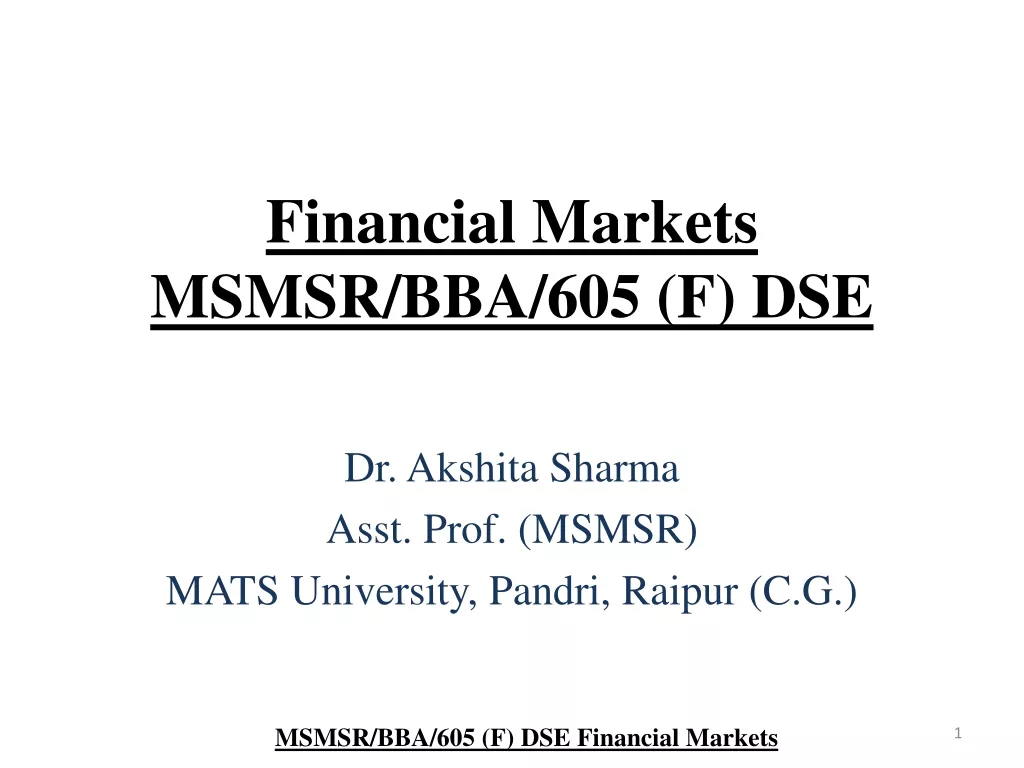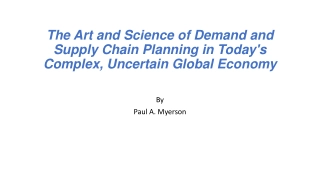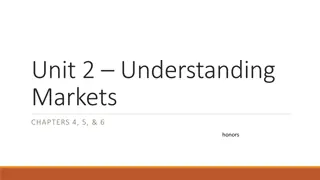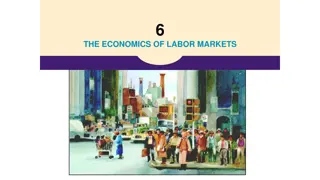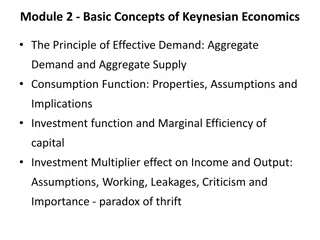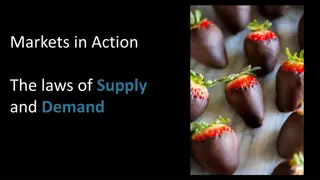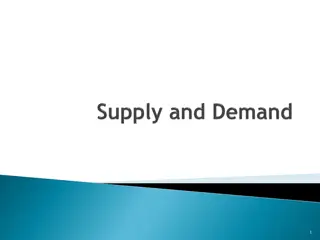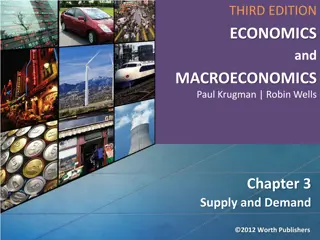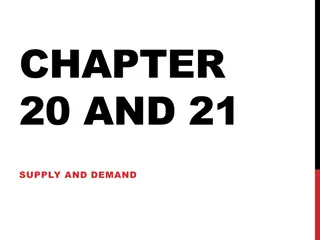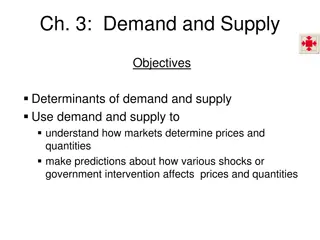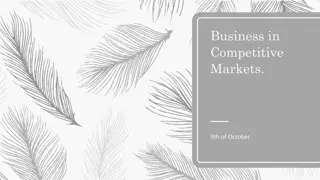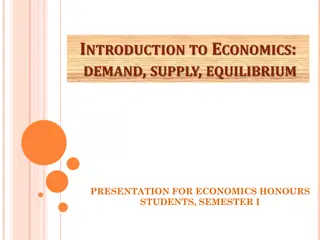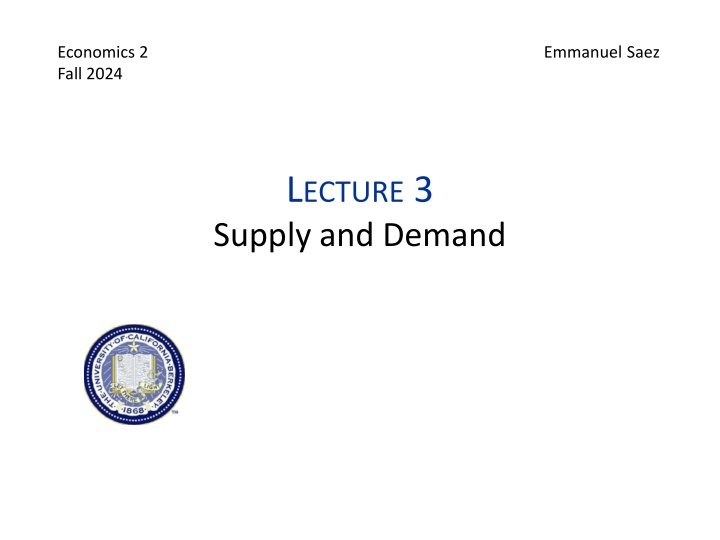
Economics: Markets, Supply, and Demand
In this lecture, we delve into the fundamentals of markets, supply, and demand. Explore the concept of market as a voluntary exchange for mutual benefit, the role of demand as the buying side of the market, and the relationship between price and quantity demanded. Understand the concept of supply as the selling side of the market, the positive relationship between quantity supplied and price, and the optimization behavior of producers. Discover the dynamics of demand and supply curves in the context of worldwide oil markets.
Download Presentation

Please find below an Image/Link to download the presentation.
The content on the website is provided AS IS for your information and personal use only. It may not be sold, licensed, or shared on other websites without obtaining consent from the author. If you encounter any issues during the download, it is possible that the publisher has removed the file from their server.
You are allowed to download the files provided on this website for personal or commercial use, subject to the condition that they are used lawfully. All files are the property of their respective owners.
The content on the website is provided AS IS for your information and personal use only. It may not be sold, licensed, or shared on other websites without obtaining consent from the author.
E N D
Presentation Transcript
Economics 2 Emmanuel Saez Fall 2024 LECTURE 3 Supply and Demand
Market An arrangement by which economic exchanges between people/firms take place Specialization in production requires us to exchange Market exchange voluntarily entered into for mutual benefit (unlike taxation from government) Exchange is often impersonal (unlike transfers/exchanges among friends, family) Market is a relatively novel form of exchange in human history (last 5000 years) anthropology: reciprocated gifts more ancient, less calculating form of exchange-like friends/families today
Demand The buying side of the market (generally consumers) There is a negative relationship between the quantity demanded of a good and its price. The relationship reflects optimizing behavior on the part of buyers: if price of the good is high, I can t buy as much or I ll buy something else. At price P, buyers want to buy quantity Q=D(P) of the good. Key assumption: buyers are price takers
Demand Curve for oil (worldwide) Price (P) D 0 Quantity (Q) 0
Demand Curve for oil (worldwide) Price (P) Rich consumers, high value users only + Poor consumers, lower value users D Quantity (Q)
Supply The selling side of the market (generally producers) There is a positive relationship between the quantity supplied of a good and its price. This relationship reflects optimizing behavior on the part of producing firms. A price P, producers are willing to supply quantity Q=S(P) of the good. Key assumption: producers are price takers
Supply Curve of oil worldwide P S High cost producers (US fracking) Low cost producers (Saudi Arabia) Q
Quiz 1: Question: Why is demand for oil sloping down? A. There are trade offs B. Oil is cheaper to produce in Saudi Arabia than North America C. Some consumers are willing to pay more for oil than others D. I don t know
Quiz 2: Question: Why is supply for oil sloping up? A. There are trade offs B. Oil is cheaper to produce in Saudi Arabia than North America C. Some consumers are willing to pay more for oil than others D. I don t know
II. MARKET EQUILIBRIUM Key assumption 1: consumers are price takers (makes sense if many small consumers) Key assumption 2: producers are price takers (makes sense if many small producers who don t collude) This is called the competitive model
Equilibrium in the Market for oil P S1 D1 Q
Equilibrium in the Market for Oil P S1 P1 Equilibrium D1 Q Q1
What happens if the price is below P1? P S1 P1 D1 Q Q1
What happens if the price is below P1? P S1 Ptoo low D1 Q
What happens if the price is below P1? P S1 Ptoo low D1 Q QS QD
What happens if the price is below P1? P S1 Ptoo low D1 Q QS QD Excess Demand (Shortage)
What happens if the price is below P1? P S1 P1 Ptoo low D1 Q Q1 QS QD Excess Demand (Shortage)
What happens if the price is above P1? P S1 P1 D1 Q Q1
What happens if the price is above P1? P S1 Ptoo high D1 Q
What happens if the price is above P1? P S1 Ptoo high D1 Q QD QS
What happens if the price is above P1? P S1 Ptoo high D1 Q QD QS Excess Supply (Surplus)
What happens if the price is above P1? P S1 Ptoo high P1 D1 Q Q1 QD QS Excess Supply (Surplus)
Equilibrium in the Market for Oil P S1 P1 Equilibrium D1 Q Q1
How Do Markets Deal with Scarcity and the Gains from Specialization? The existence of markets allows people to specialize along the lines of comparative advantage because they can trade for other goods that they want. Markets deal with scarcity by balancing the optimizing behavior of consumers and producers. Prices adjust to equilibrate the two sides of the market. The consumers who actually get the good are those who are willing and able to pay the equilibrium price. The firms that actually produce the good are those that find it profit-maximizing to produce at the equilibrium price.
III. SHIFTSINTHE CURVES We have looked at the equilibrium where given demand and supply curves intersect We now analyze how the equilibrium changes when supply or demand curves shift
Ceteris Paribus other things being equal We have been looking at the relationship between the quantity demanded and price and between the quantity supplied and price, assuming that the only thing that varies is the price.
Oil market: Supply goes up A new technology (fracking) P S1 P1 D1 Q Q1
Oil market: Supply goes up A new technology (fracking) P S1 S2 P1 D1 Q Q1
Oil market: Supply goes up A new technology (fracking) P S1 S2 P1 P2 D1 Q Q1 Q2 When supply goes up, quantity increases and the price decreases
Oil market: Supply goes down The US bans fracking P S2 S1 P2 P1 D1 Q Q1 Q2 When supply goes down, quantity decreases and the price increases
What can shift supply curves? Outward supply shifts (supply increases, goes up): Innovation that increases productivity Prices of inputs needed for production going down More producers enter the industry Inward supply shifts (supply decreases, goes down): Regulation decreases productivity Prices of inputs needed for production going up Producers exit the industry
Oil market: Demand goes down Electric cars appear P S1 P1 D1 Q Q1
Oil market: Demand goes down Electric cars appear P S1 P1 D2 D1 Q Q1
Oil market: Demand goes down Electric cars appear P S1 P1 P2 D2 D1 Q Q2 Q1 When demand goes down, quantity decreases and the price decreases
Oil market: Demand goes up US bans electric cars P S1 P2 P1 D2 D1 Q2 Q Q1 When demand goes up, quantity increases and the price increases
What can shift demand curves? Outward demand shifts (demand increases, goes up) New complementary good is released The price of a substitute good goes up People got richer The product becomes fashionable Inward demand shifts (demand decreases, goes down) The price of a complementary good goes up The price of a substitute good goes down The product goes out of fashion or becomes obsolete
Quiz 3: Question: World market for oil. Europe removes its ban on fracking (lots of oil sits deep in European continent). What is the effect on P & Q of oil worldwide? A. P increases, Q increases B. P decreases, Q increases C. P increases, Q decreases D. P decreases, Q decreases E. P effect unknown, Q decreases
Quiz 4: Question: Market for rental apartments in city of Berkeley. UC Berkeley opens the new Anchor House building that provides 244 new apartments for 772 UC students (at market prices). What is the effect on P & Q of rental apartments in Berkeley? A. P increases, Q increases B. P decreases, Q increases C. P increases, Q decreases D. P decreases, Q decreases E. P effect unknown, Q decreases
Quiz 5: Question: UC Berkeley increases the size of its undergraduate class from current 8000 to 10000. What is the effect on P & Q of rental apartments in the city of Berkeley? A. P increases, Q increases B. P decreases, Q increases C. P increases, Q decreases D. P decreases, Q decreases E. P effect unknown, Q decreases
Estimating Demand Curves Empirically In real data, we observe only the intersection of supply and demand curve, not the curves Demand curve is revealed in real data when there is a supply shift with stable demand curve. Working (1925) is early example using potatoes in Minneapolis area: annual production varies with weather (supply shift) while demand curve is expected to be stable Is this compelling estimation?
Supply shifts can reveal the demand curve P S1 S2 P1 P2 D1 Q Q1 Q2 When supply shifts, equilibrium moves along the demand curve
Estimating Demand Curves Empirically Demand curve is revealed in real data when there is a supply shift with no change in demand curve Working (1925) is early example using potatoes in Minneapolis area: annual production varies with weather (supply shift) while demand curve is expected to be stable Is this compelling estimation? Yes, for 1925 but: Weather can affect other crops and their prices and that can affect demand for potatoes as well Ideal would be to have exogenous change in price of potatoes only and look at demand response
Randomized experiments to Estimate Demand Randomized experiments: sample is randomized into treatment vs. control (like medical science experiment) Widely used today in development economics (Banerjee, Duflo, Kremer 2019 nobel prize) Studies offer important preventive health products at randomized prices to estimate demand [ultimate goal of studies is to study health impacts]
Figure 2. Purchase rate of preventive health products, by TIOLI price, Dupas and Miguel (2017)
Randomized experiments to Estimate Demand Randomized experiments: sample is randomized into treatment vs. control (like medical experiment) Widely used today in development economics (Banerjee, Duflo, Kremer 2019 nobel prize) Studies offer important preventive health products at randomized prices to estimate demand Higher prices sharply reduce demand Demand small at market prices for many such goods in spite of substantial future health (and hence economic) benefits Makes sense for government to provide such goods (instead of market allocation) if consumers don t value/buy products Libertarian vs. socialism debate

